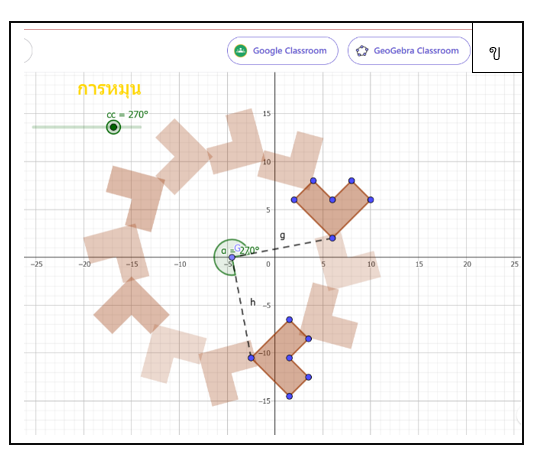การคิดเชิงเรขาคณิตและความเข้าใจทางคณิตศาสตร์ เรื่อง การแปลงทางเรขาคณิต ของนักเรียนชั้นมัธยมศึกษาปีที่ 2 โดยใช้โปรแกรม GeoGebra
Main Article Content
บทคัดย่อ
การวิจัยในครั้งนี้มีวัตถุประสงค์ 1) เพื่อเปรียบเทียบการคิดเชิงเรขาคณิต เรื่อง การแปลงทางเรขาคณิต ของนักเรียนชั้นมัธยมศึกษาปีที่ 2 ที่ได้รับการจัดการเรียนรู้โดยใช้โปรแกรม GeoGebra กับเกณฑ์ร้อยละ 75 2) เพื่อเปรียบเทียบความเข้าใจทางคณิตศาสตร์ เรื่อง การแปลงทางเรขาคณิต ของนักเรียนชั้นมัธยมศึกษาปีที่ 2 ที่ได้รับการจัดการเรียนรู้โดยใช้โปรแกรม GeoGebra กับเกณฑ์ร้อยละ 75 และ 3) เพื่อศึกษาเจตคติของนักเรียนชั้นมัธยมศึกษาปีที่ 2 หลังการจัดการเรียนรู้โดยใช้โปรแกรม GeoGebra กลุ่มตัวอย่างที่ใช้ในการวิจัย คือ นักเรียนชั้นมัธยมศึกษาปีที่ 2 โรงเรียนอนุกูลนารี จังหวัดกาฬสินธุ์ จำนวน 156 คน ที่ได้มาจากการสุ่มอย่างง่าย เครื่องมือที่ใช้ในการวิจัย ประกอบด้วย แผนการจัดการเรียนรู้ เรื่อง การแปลงทางเรขาคณิต จำนวน 12 แผน แบบทดสอบวัดการคิดเชิงเรขาคณิตและความเข้าใจทางคณิตศาสตร์ แบบวัดเจตคติ วิเคราะห์ข้อมูลโดยใช้สถิติพื้นฐาน ได้แก่ ค่าเฉลี่ย (X̄) ส่วนเบี่ยงเบนมาตรฐาน (S.D.) ร้อยละ และการทดสอบที (t-test for one sample) ผลการวิจัย พบว่า นักเรียนมีการคิดเชิงเรขาคณิตของนักเรียนชั้นมัธยมศึกษาปีที่ 2 ที่ได้รับการจัดการเรียนรู้โดยใช้โปรแกรม GeoGebra คิดเป็นร้อยละ 81.33 สูงกว่าเกณฑ์ร้อยละ 75 อย่างมีนัยสำคัญทางสถิติที่ระดับ .01 และนักเรียนมีการคิดเชิงเรขาคณิตทุกระดับสูงกว่าเกณฑ์ร้อยละ 75 อย่างมีนัยสำคัญทางสถิติที่ระดับ .01 นักเรียนมีความเข้าใจทางคณิตศาสตร์ ของนักเรียนชั้นมัธยมศึกษาปีที่ 2 ที่ได้รับการจัดการเรียนรู้โดยใช้ GeoGebra มีคะแนนเป็นร้อยละ 82.81 ซึ่งสูงกว่าเกณฑ์ร้อยละ 75 อย่างมีนัยสำคัญทางสถิติที่ระดับ .01 ซึ่งสอดคล้องกับสมมติฐานที่ตั้งไว้ และเมื่อพิจารณารายด้าน พบว่า นักเรียนมีความเข้าใจทางคณิศาสตร์ระดับการกระทำ สูงสุด ร้อยละ 84.78 รองลองมา คือระดับกระบวนการ ร้อยละ 83.33 ระดับโครงสร้างทางปัญญา ร้อยละ 82.85 และระดับวัตถุ ร้อยละ 80.29 ตามลำดับ และเจตคติของนักเรียน ในภาพรวมอยู่ในระดับมากที่สุด ( = 4.72, S.D. = 0.51)
Article Details

อนุญาตภายใต้เงื่อนไข Creative Commons Attribution-NonCommercial-NoDerivatives 4.0 International License.
วารสารวิทยาศาสตร์และวิทยาศาสตร์ศึกษา (JSSE) เป็นผู้ถือลิสิทธิ์บทความทุกบทความที่เผยแพร่ใน JSSE นี้ ทั้งนี้ ผู้เขียนจะต้องส่งแบบโอนลิขสิทธิ์บทความฉบับที่มีรายมือชื่อของผู้เขียนหลักหรือผู้ที่ได้รับมอบอำนาจแทนผู้เขียนทุกนให้กับ JSSE ก่อนที่บทความจะมีการเผยแพร่ผ่านเว็บไซต์ของวารสาร
แบบโอนลิขสิทธิ์บทความ (Copyright Transfer Form)
ทางวารสาร JSSE ได้กำหนดให้มีการกรอกแบบโอนลิขสิทธิ์บทความให้ครบถ้วนและส่งมายังกองบรรณาธิการในข้อมูลเสริม (supplementary data) พร้อมกับนิพนธ์ต้นฉบับ (manuscript) ที่ส่งมาขอรับการตีพิมพ์ ทั้งนี้ ผู้เขียนหลัก (corresponding authors) หรือผู้รับมอบอำนาจ (ในฐานะตัวแทนของผู้เขียนทุกคน) สามารถดำเนินการโอนลิขสิทธิ์บทความแทนผู้เขียนทั้งหมดได้ ซึ่งสามารถอัพโหลดไฟล์บทความต้นฉบับ (Manuscript) และไฟล์แบบโอนลิขสิทธิ์บทความ (Copyright Transfer Form) ในเมนู “Upload Submission” ดังนี้
1. อัพโหลดไฟล์บทความต้นฉบับ (Manuscript) ในเมนูย่อย Article Component > Article Text
2. อัพโหลดไฟล์แบบโอนลิขสิทธิ์บทความ (Copyright Transfer Form) ในเมนูย่อย Article Component > Other
ดาวน์โหลด ไฟล์แบบโอนลิขสิทธิ์บทความ (Copyright Transfer Form)
เอกสารอ้างอิง
Battista, M. T. (2007). The development of geometric and spatial thinking. In F. K. Lester (Ed.), Second handbook of research on mathematics teaching and learning (pp. 843-908). Information Age Publishing.
Charnprasert, S. (2014). Active learning: Learning management in the 21st century. IPST magazine, 42(188), 3-6.
Charnprasert, P. (2014). Mathematics instruction in the digital age. Journal of Education, 22(2), 45-58.
Dubinsky, E. (1991). Reflective abstraction in advanced mathematical thinking. In D. Tall (Ed.), Advanced mathematical thinking (pp. 95–123). Kluwer Academic Publishers.
Hancherngchai, S., Inprasitha, M. and Thinwiangthong, S. (2017). Mathematics Teacher Education Program for 21st Century. HRD JOURNAL, 8(1), 55-66.
Hohenwarter, M. and Fuchs, K. (2004). Combination of dynamic geometry, algebra and calculus in the software system GeoGebra. Proceedings of the Computer Algebra Systems and Dynamic Geometry Systems in Mathematics Teaching Conference (pp. 1-6). 2004. Pécs, Hungary.
Jan-ngam, P. and Suanpradit, A. (2021). Development of electronic media (E-book) using GeoGebra software. Journal of Research and Development for Education, 6(2), 105-115.
Kanachan, J., Kaewkhamson, K., Nongharnpituk, P. and Khansila, P. (2020). A study of learning achievement in the applications of derivative topic for Grade-12 students taught by incorporating GeoGebra program into mathematics problem-solving based on Polya's method (in Thai). Journal of Science and Science Education, 3(1), 73-83.
Khansila, P., Yonwilad, W., Nongharnpituk, P. and Thienyutthakul, S. (2022). Improving Academic Performance in Geometry Using a Mastery Learning Approach through GeoGebra. Journal of Educational Issues, 8(2), 876-894.
Ministry of Education. (2017). Indicators and Core Content Mathematics Department (Revised Version B.E. 2560, A.D.2017) The Basic Education Care Curriculum B.E. 2551 (A.D. 2008). (in Thai). The Agricultural Cooperative Federation of Thailand Limited.
National Council of Teachers of Mathematics. (2000). Principles and standards for school mathematics. Principles and Standards for School Mathematics. Reston, VA: NCTM.
National Institute of Educational Testing. (2023). Results of the Basic Education National Test for Grade 9 Mathematics, Academic Year 2023. Retrieved 10 September 2024, from Go ToKnow: https://newonetresult.niets.or.th/AnnouncementWeb/Notice/FrBasicStat.aspx
Phoodee, W. (2020). Mathematics instruction in digital age: Methods and tools (in Thai). Journal of Science and Science Education, 3(2), 190-199.
Skemp, R. R. (1976). Relational understanding and instrumental understanding. Mathematics Teaching, 77, 20–26.
The Institute for the Promotion of Teaching Science and Technology. (2012). Guidelines for Mathematics Learning Management at the Primary School Level (p. 189). Bangkok: Institute for the Promotion of Teaching Science and Technology.
The Institute for the Promotion of Teaching Science and Technology. (2017). A guide to using the curriculum to learn mathematics (revised version B.E. 2560) according to the core curriculum for basic education, 2008.Retrieved 17 September 2024, from Go ToKnow: https://www.scimath.org/ebook-mathematics/item/8380-2560-2551-8380
Thongma, T. (2018). Mathematics learning resources for mobile learning in digital age (in Thai). Journal of Educations studies, Chulalongkorn University, 46(1), 251-256.
Van Hiele, P. M. (1986). Structure and insight: A theory of mathematics education. Academic Press.
Vojkuvkova, I. (2012). The van Hiele model of geometric thinking. Proceedings of the 21st Annual Conference of Doctoral Students – WDS 2012 (pp. 72–75). Czech Republic: Charles University.
Worasarn, J., Nongharnpituk, P. and Khansila, P. (2019). Development of learning activities emphasizing mathematical processes using GeoGebra program on system of linear equations with two variables topic for grade-9 students (in Thai). Journal of Science and Science Education, 2(1), 34 -42.


